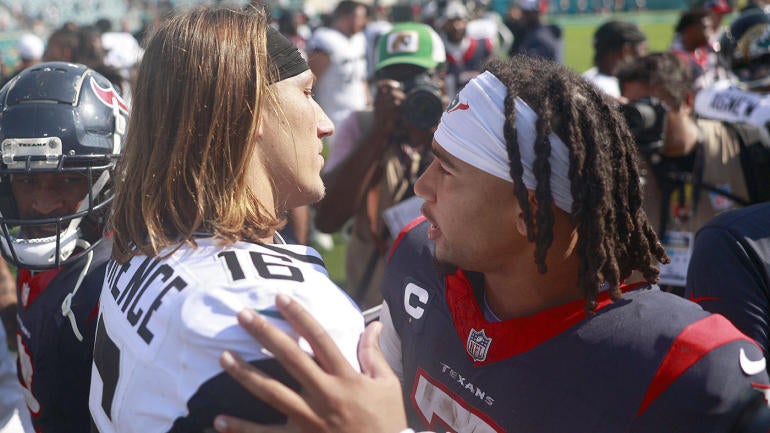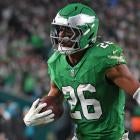
There's no more important position in sports than quarterback. If the position wasn't entertaining enough to follow, we're currently in an era featuring the most volatile, highest-paid, injury-prone, youngest and talented group of QBs in NFL history.
Here's five trends you need to know:
1. Age of impatience
It's no secret we live in a world where we want things now, now, now! We can order something online and get it delivered on the same day. In the NFL, teams want their blue-chip QBs to deliver immediately, too.
It's becoming the age of impatience, as the average number of career starts by QBs drafted in the first round in the 2010s is currently 52. Even if you project signal-callers like Patrick Mahomes, Josh Allen, Kyler Murray and Lamar Jackson to double their start total for their respective teams, that number only jumps to the mid-60s, a far cry from the 2000s (81) and most other decades.
Average career starts for draft team (First-round QBs by draft decade)
- 2010s – 52
- 2000s – 81
- 1990s – 50
- 1980s – 73
- 1970s – 76
Roughly 40% of QBs drafted in the first round in the 2010s signed a second deal with their draft team. Plus, the two previous mega QB classes (2018 and 2021) have only seen three of the 10 first-round QBs get a second deal with their draft teams.
Why are these figures so low? There are plenty of theories. Head coaches and front offices are under immense pressure, too, so starting over at QB can buy them extra time. QBs are valued so high in today's game they are overdrafted and underprepared. QBs are thrown into the fire quickly and have to learn on the job, rather than sit most of their rookie seasons (first-round rookie QBs average 10 starts per year in the last decade.)
In some cases, as the Browns can attest, wisdom dwells with prudence. Their decision to move on from Baker Mayfield and invest $230 million guaranteed (and three first-round picks) in Deshaun Watson looks worse by the day.
2. Show me the money!
Speaking of Watson, QBs are getting paid more and more handsomely, even getting a larger slice of the pie. Joe Burrow's new contract signed last year represented 25% of the Bengals' cap in terms of his average annual salary, per Spotrac. It's the highest figure in the entire league and well above Aaron Rodgers' market-setting contract in 2018, which was 19% of the Packers' cap. There's now 12 QBs who account for a bigger slice of the pie in 2024.
3. Are injuries up?
Every year it seems like QB injuries are through the roof despite the NFL's efforts to protect signal-callers. Last year we saw names like Aaron Rodgers, Anthony Richardson, Deshaun Watson, Daniel Jones, Joe Burrow, Kirk Cousins and Justin Herbert suffer season-ending injuries. So are injuries actually up, or are we just prisoners of the moment? Yes, the numbers support that QB injuries are up:
- There were 66 different starting QBs in 2023, the second most in a season all time behind 68 in 2022. That number has been steadily on the rise since 2012, when there were 48.
- Only nine QBs started every game last season, the lowest total since 1999. The average was 14 from 2000-22.
- This was the second straight year that season-opening starting QBs missed at least 24% of possible starts. Prior to that, that number hadn't been 24 percent or higher since 2008.
The age of impatience documented above could play into this. But, it also makes sense that we are seeing more QB injuries based on teams dropping back to pass more, QBs running more and more opportunity to get hurt with the expansion to a 17-game schedule. It also doesn't help that we are seeing worse offensive line play due to less practice time in the offseason, among other reasons. Last season saw the highest sack and pressure rates on record.
Percent of starts missed by Week 1 starting QBs
- 2023 – 24%
- 2022 – 25%
- 2021 – 18%
- 2020 – 19%
- 2019 – 21%
- 2018 – 22%
- 2017 – 20%
- 2016 – 18%
- 2015 – 17%
4. Youth movement
The changing of the QB guard is virtually complete with Tom Brady, Peyton Manning, Drew Brees, Philip Rivers, Ben Roethlisberger, Matt Ryan and Eli Manning out of the league, with Aaron Rodgers as the biggest holdover from the old guard.
We could be looking at the youngest QB crop in NFL history after six of them were drafted in the top 12 picks for the first time ever. Last year already featured the second-youngest starting QB group ever (average age: 27) since 1956 (26).
5. Style of play
The youth movement has come with its growing pains. The league averaged 10.9 yards per completion last year, the fourth straight year it's been the worst in a season in NFL history. The average pass continues to trickle shorter and shorter as it was 7.7 air yards per attempt in 2023, down a full yard from 2011.
On the bright side though, QBs are more entertaining in some regards. Signal-callers accounted for 16% of teams' rushes in 2023, the highest rate in NFL history. There's been more 500-yard rushing seasons by QBs in the last 10 years (35) than the previous 90-plus combined (31).
At the end of the day, the position is not in the best state it's ever been, as Tom Brady recently shared, but it's more polarizing and volatile than ever before.

















